Grade
Water conditions
I
Moving water with riffles and small waves. Few obstructions, all obvious, and easily missed with little training. Risk to swimmers is slight; self-rescue is easy
II
Straightforward rapids with wide, clear channels. Occasional maneuvering required, but rocks and medium-sized waves are easily avoided
III
Moderate rapids that include irregular waves, strong eddies, and a powerful current. Good boat control and regular maneuvering required to avoid obstacles (boulders & small drops). More pronounced obstacles (large waves or strainers) may be present but are easily avoided
IV
Intense, powerful, turbulent, but predictable rapids often featuring large, unavoidable waves and holes. Requires precise boat handling and fast maneuvers under pressure. Scouting may be necessary the first time down. Risk of injury to swimmers is moderate to high, and a strong eskimo roll is highly recommended
V
Extremely long, obstructed, or very violent rapids that expose a paddler to added risk. Frequent large, unavoidable waves, and holes or steep, congested chutes with complex, demanding routes. Few eddies that are small, turbulent, and difficult to reach. Scouting is recommended but often difficult. Swims are dangerous, and rescue is difficult even for experts. A very reliable eskimo roll, proper equipment, extensive experience, and rescue skills are essential
VI
These runs have almost never been attempted and often exemplify the extremes of difficulty, unpredictability, and danger. The consequences of errors are very severe, and rescue may be impossible. For teams of experts only, at favorable water levels, after close personal inspection and taking all precautions
Modern canoeing is a diverse sport, and the International Canoe Federation (ICF) oversees competitive canoeing across 11 disciplines that encompass a wide range of different craft, paddles, and water conditions. The principal ICF competitive whitewater disciplines are canoe slalom, wildwater canoeing, and canoe freestyle (Table 6.2; in this context canoeing is the overarching term for all canoe and kayak activities, although most of the disciplines have specific canoe and kayak classes). In addition, the water conditions in some canoe marathon and ocean racing (surfski) events include whitewater paddling depending on the course and prevailing weather conditions. The disciplines of rafting and surf/waveski also take place on whitewater.
Table 6.2
Competitive whitewater disciplines
Discipline | Description of competition |
|---|---|
Canoe slalom | Timed completion of up to 25 gates while negotiating a ∼300 m course of whitewater rapids (Fig. 6.1a, b) 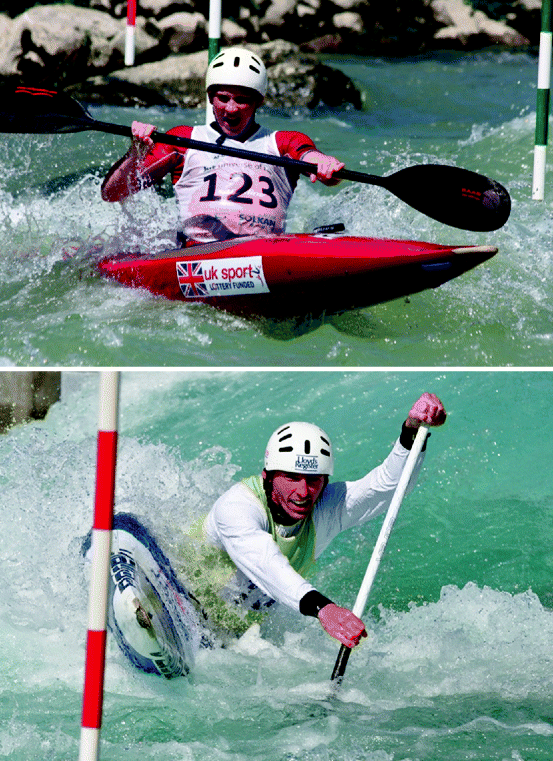 Fig. 6.1 Canoe slalom competitors in the Men’s K1 (top) and C1 classes (bottom). The crossbow stroke shown by the C1 paddler requires considerable flexibility and balance. These craft are designed for maneuverability and stability being relatively short with a flat-bottomed hull (Pictures courtesy of Andy Maddock (top) and Jon Royle (bottom)) |
Wildwater canoeing | Descent of a section of whitewater rapids in the fastest time. Classic race >3 km, sprint race <1 km (Fig. 6.2) 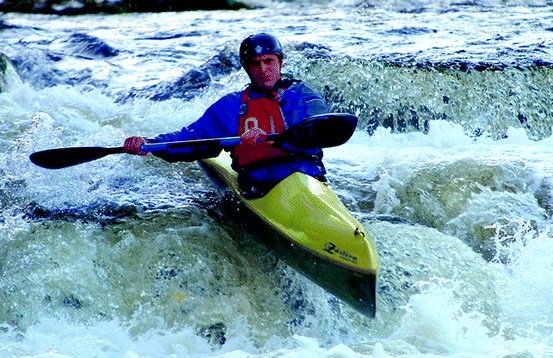 Fig. 6.2 A paddler in the Men’s K1 class of a wild-water canoeing competition (one of the ICF competitive disciplines) descends a grade III fall. Note the long sleek craft that is designed for speed when descending whitewater as fast as possible (Picture courtesy of Jon Royle) |
Canoe freestyle | Acrobatic tricks/maneuvers performed on a specific whitewater river feature, e.g., wave or hole (Fig. 6.3) 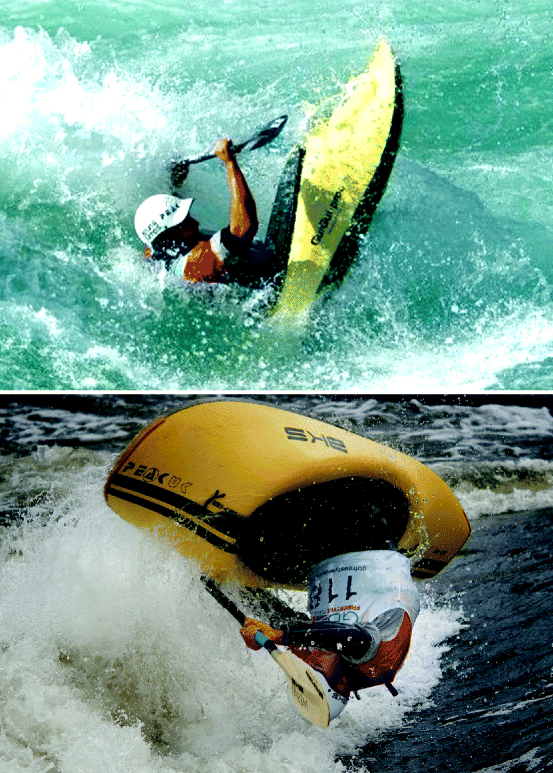 Fig. 6.3 Freestyle kayak paddlers perform some spectacular maneuvers (Pictures courtesy of Jen Chrimes) |
Rafting | Racing with four to eight people in raft. The World Championships have sprint, head-to-head, slalom and downriver events (Fig. 6.4) 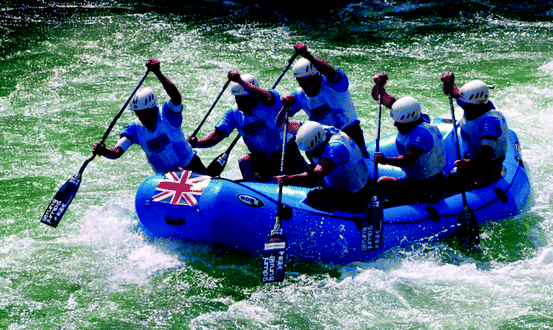 Fig. 6.4 A six-person raft in competition. Commercial rafting often involves larger eight to ten-person rafts with the raft guide seated at the back from where they can see all of the paddlers and the river ahead, as well as steer the raft (Picture courtesy of Lawrence Harris) |
Surf/waveski | Stunts/maneuvers performed while surfing a wave into shore (Fig. 6.5a, b) 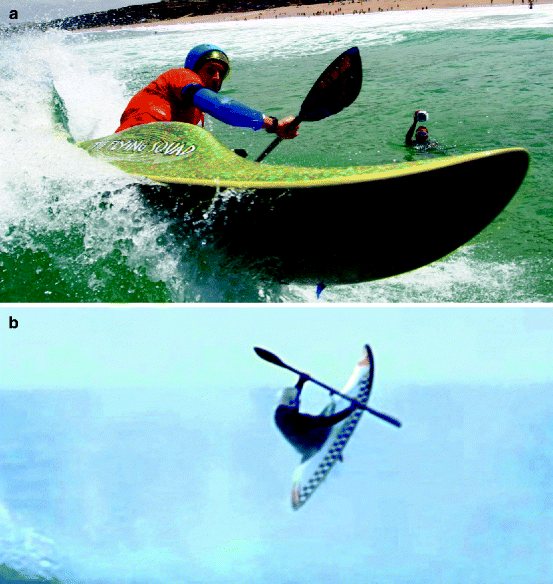 Fig. 6.5 Surf paddlers perform a top turn high on a wave (a) and an aerial maneuver (b) (Pictures courtesy of Stephen Bowens) |
The essence of these competitive disciplines is practiced extensively at recreational level and often described as playboating, whitewater touring, or river running. The most challenging and extreme whitewater paddling involves descending grade V and VI rapids, including shooting waterfalls (Fig. 6.6a, b), as well as exploring new or seldom-navigated rivers typically in remote wilderness locations. In addition, recreational rafting is an extensive commercial adventure tourist activity in many mountainous parts of the world. In the year 2000, it was estimated that that there were ∼10 million rafting participants and ∼2 million whitewater canoe/kayak paddlers in the USA annually [35].
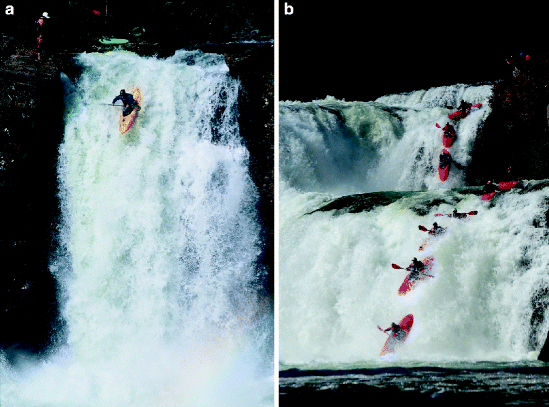

Fig. 6.6
(a) A kayak paddler, in a typical playboat, descends a substantial waterfall (Picture courtesy of Omer Mei-Dan) (b) A kayak paddler picks up the best “line” down a “2-stage” waterfall (Picture: David Carlier)
This chapter will primarily consider whitewater accidents, injuries, and relevant illnesses. The prevention and treatment of the most prevalent will be reviewed with some reference to flatwater paddling injuries, due to their relevance. While canoeing is the overarching term for all canoe and kayak activities, for precision in the remainder of this chapter, the terms canoeing (propelled with a single-bladed paddle typically from a kneeling position) and kayaking (propelled with a double-bladed paddle from a seated position) will be used in their more specific sense.
Craft, Equipment, and Safety Recommendations
Whitewater canoes and kayaks come in different shapes and sizes, depending on the purpose of the craft and expected water conditions. Craft designed with an emphasis on linear speed are long and sleek to reduce drag, e.g., wildwater, touring, or marathon kayaks (3.5–5.2m). Slalom, freestyle, and surf craft are typically shorter for increased maneuverability (3 m and <2 m, respectively) and flat bottomed for greater stability. For higher grade whitewater (III+), decked craft are the norm. Those designed for “heavy” (highly aerated) whitewater are higher volume compared to those intended for smaller whitewater, with an extreme being squirt boats – a form of freestyle kayak that can perform subsurface maneuvers even on flatwater. Competition canoes and kayaks are constructed from composite materials to minimize weight and maximize performance. Modern recreational canoes and kayaks are constructed from polyethylene plastic in order to maximize durability, although this comes at the cost of increased weight. These stronger plastic boats have led to the exploration of smaller steeper creeks, the running of waterfalls, and the evolution of the modern playboat that is shorter than more traditional canoes and kayaks. Playboats have also evolved to have highly rounded ends in order to reduce the risk of pinning the craft in a dangerous manner. Inflatable and sit-on-top canoes and kayaks have also become increasingly popular, particularly with novice paddlers and for grade I–II water. Modern rafts are constructed from inflatable rubber with multiple chambers aiding buoyancy (even if one chamber is punctured). Raft paddlers sit perched on the outer tube with both legs in the raft and use a longer paddle to reach the water (Fig. 6.4).
In the event of capsize, sufficient boat buoyancy is an important safety feature as upturned canoes or kayaks filled with water are extremely heavy and difficult to extract from a fast flowing river. In contrast a buoyant capsized boat can provide an excellent flotation aid to a swimmer struggling to stay on the surface of turbulent water. For this reason, removable air bags placed inside the craft are a standard requirement for Whitewater competitions and strongly recommended for recreational paddling.
Paddle design is largely dependent on the craft and canoeing discipline plus the physique and ability of the paddler (Fig. 6.7). Craft with greater linear speed tend to be propelled with longer paddles that have a larger blade area. For these faster craft, kayak paddles with a greater feather angle (45–85°) and winged blades (“spoon” shaped with a distinct upper lip) are commonly used. Cranked shaft paddles are popular among slalom kayakers and have been suggested to improve performance and reduce injury risk.
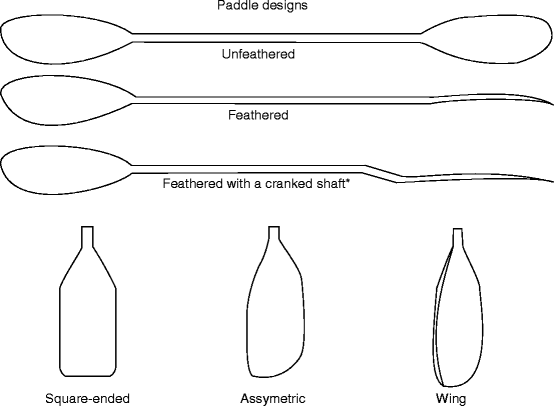

Fig. 6.7
Some of the main alternatives of kayak paddle design. *Note that cranked shaft paddles have a crank where both hands grip the shaft
Personal flotation devices (PFD) or buoyancy aids are essential personal equipment for all Whitewater paddle sports. This is reinforced by statistics from two surveys where a high proportion of fatalities (68 and 92 %) were not wearing a PFD [9, 11]. The minimum competition standard is 60 N of buoyancy (EN/ISO 12402-5), but for more severe conditions/river grades, higher levels of buoyancy are recommended and may be crucial in helping to keep a swimmer on the surface. A helmet is also essential personal equipment. Approved helmets (e.g., CE EN 1985) are recommended for all Whitewater activities. For more extreme Whitewater helmets incorporating jaw and/or face protection may also be appropriate. Face guards are more relevant for rafters due to the higher incidence of reported facial injuries.
The water temperature of alpine or mountain rivers is often just a few degrees above freezing; therefore, even in warm/hot air temperatures, wet or dry suits can be an important safety precaution, mitigating the risk of hypothermia during a prolonged capsize and swim. Wet suits also provide other advantages, increasing personal buoyancy and reducing abrasion/impact injuries if a paddler should be separated from their craft. Watertight clothing and equipment, including a spraydeck, help to maintain body temperature and prevent craft becoming water logged, which causes a rapid loss of paddler control.
Throw bags are an important piece of equipment when there is a significant chance of capsize. A throw bag thrown from a stable position into swift water or rapids enables a swimmer to grab the rope and be pulled to safety.
Many paddle sport organizations (clubs, federations, etc.) offer courses, tuition, and extensive information on safe Whitewater paddling. Table 6.3 contains a summary of important safety advice for all Whitewater paddlers issued by American Whitewater.
Table 6.3
A summary of the Whitewater Safety Code of American Whitewater
Whitewater safety advice |
|---|
Know your limitations |
Be able to swim at least 50 m |
Know the water/course and weather conditions |
Always wear a buoyancy aid/life jacket/personal flotation device |
Always have a float plan (i.e., others know where you are going and when you’ll be back) |
Have the appropriate clothing/equipment for the conditions, e.g., helmet |
Paddle in a group |
Avoid drugs and alcohol prior to paddling |
Know what to do in the event of a capsize |
Overview of Whitewater Accidents and Injuries
Accidents and injuries in Whitewater paddle sport are relatively rare, but due to the unpredictable nature of the Whitewater environment, the consequences can be severe. Most river fatalities are thought to occur in inexperienced paddlers attempting rivers beyond their skill, in adverse weather or high water conditions, and without appropriate safety gear [8]. Submersion accidents are the primary life-threatening hazard, possibly accounting for ∼1/3 of all Whitewater injuries [27] that include drowning, near drowning, and impact-related trauma while submerged. Fortunately fatalities are relatively rare, occurring at a rate of 8.7 per 1,000,000 user days for rafters, canoeists, and kayakers [50], which is similar to trekking [42]. The primary causes of drowning in whitewater are entrapment, blunt head trauma, or hypothermia leading to disorientation or loss of consciousness. Sudden immersion in cold water can cause hyperventilation, bronchospasm, and even cardiac arrest [4]. Therefore, all participants should be prepared for a capsize (as it is an integral part of the sport) and advised to wear appropriate watertight clothing with sufficient insulation (e.g., spray deck, waterproof jacket/cagoule, wet/dry suit). Submersion accidents and injuries primarily occur during a capsize or when a paddler is swimming downriver separated from their craft. Capsized paddlers and swimmers are also susceptible to hematomas, contusions, abrasions, and lacerations from contact with rocks and other objects, as they are carried downstream.
The incidence of Whitewater injuries has been estimated as 4.5 and 5.2 injuries per 1,000 paddler days among recreational [41] and competitive slalom [28] canoeists and kayakers. This is a similar injury incidence to alpine skiing, but higher than cross-country skiing or windsurfing [22, 34]. The injury incidence in commercial rafters appears to be lower at 0.26–0.44 injuries per 1,000 paddler days [49]. As with most sports, the incidence of Whitewater injuries rises with increased exposure [41] and is substantially greater during competition than training (ten times higher in competitive slalom paddlers [28]). The etiology of injuries/illnesses sustained by paddlers can be divided into acute trauma, chronic overuse, and environmental (Table 6.4). There are relatively few detailed reports in the scientific and medical literature regarding specific Whitewater injuries. Previous studies have typically been retrospective surveys relying on self-reporting, rather than any professional diagnoses.
Table 6.4
Common acute traumatic, chronic overuse, and environmental injuries/illnesses in whitewater canoeing, kayaking, and rafting
Acute traumatic | Chronic overuse | Environmental |
|---|---|---|
Lacerations/abrasions | Tendinopathies of the wrist, forearm, elbow, and shoulder | Drownings/near drownings |
Contusion/hematomas | Muscle strain of the lower back and vertebral disk degeneration | Blisters/calluses on hands |
Shoulder dislocations | Rotator cuff impingement | Fungal and bacterial skin infections |
Fractures | Rib stress fractures | Gastroenteritis |
Head and face injuries | Otitis media and otitis externa | |
Muscle strains and joint sprains | Cold/heat injury | |
Leptospirosis |
Unsurprisingly for a predominantly upper body sport, the majority of injuries in canoeists and kayakers involve the wrist, forearm, elbow, and shoulder. Rafters have a different pattern of injury with more face (33 %) and knee injuries (15 %) and fewer shoulder injuries (6 %) [7].
The only evidence on severity of Whitewater injuries is from the surveys observing that 42–51 % of all injuries reported required medical attention [16, 41]; one survey showed that the severe injuries were similar in nature to milder injuries, i.e., 47 % acute versus 36 % chronic [41]. The shoulder was the most common site for severe injury in canoe/kayak paddlers, with 15 % of respondents in one survey reporting at least one dislocation [28] and more than half a cohort of elite slalom paddlers reporting a history of shoulder injury [15].
More than 50 % of all rafting injuries occur on the raft and include collisions with other rafters, impacts from paddles or other equipment, and entanglement of extremities within the raft. 40 % of rafting injuries occur when paddlers are ejected from the raft [49]. In Whitewater kayakers, 87 % of injuries occurred while in the boat, 8 % when in the water having abandoned their craft, and 5 % while walking or portaging [16].
Acute Injuries
The majority of Whitewater injuries are of an acute traumatic nature, accounting for 57–61 % of all injuries [28, 41]. The most common acute injuries in canoe/kayak paddlers were sprains (35 % of acute injuries) and tendonitis (20 %) in one survey [28] and sprain/strain (26 %), lacerations (17 %), and contusions (17 %) in another [41]. In rafters the most common acute injuries are similar: lacerations (33 %), strains and sprains (23 %), fractures (23 %), and contusions/bruises (10 %) [49].
Fractures, Lacerations, and Abrasions
The predominant cause of fractures, lacerations, contusions, and abrasions is direct impact with rocks, the river bed, or other paddlers/equipment [41]. Fractures can vary from the minor undisplaced finger fractures to life- or limb-threatening injuries, the more severe injuries being more frequent on higher grade whitewater. Surveys of paddlers, both amateur and elite, have reported similar fracture occurrence rates 5–9 % of acute injuries [28, 41]. There is no detail on the exact diagnoses, but 19 % of acute ankle/foot injuries and back/chest/hip injuries were fractures. 14 % of acute wrist and forearm injuries were also reported as being fractures [41].
Acute Muscle Strains and Joint Sprains
While the etiology of these acute injuries has not been documented, they are likely to result from sudden overload of a muscle group or joint. The mechanical limits of the muscle or joint tissues may be exceeded when making a very forceful movement to negotiate an object/gate or performing a “last-ditch” support stroke or roll. With the shoulder and lower back thought to be at greatest risk of acute strain or sprain.
In the canoe class of paddlers, although not reported in the literature, hip flexor muscle strains and quadriceps/hamstring strains can occur due to the kneeling position and consequent loading of these structures.
Shoulder Dislocation
In one survey of canoe and kayak paddlers, 15 % of respondents reported at least one shoulder dislocation [28]. This is a severe injury that typically results in several weeks of shoulder immobilization and a prolonged absence from paddling. Dislocation and subluxations are mostly due to anterior displacement of the humeral head that commonly occurs when a paddler is forced to brace strenuously to avoid capsize. Extreme bracing or support strokes inevitably involve a high degree of shoulder abduction, which if pronounced and combined with simultaneous external rotation and extension can lever the humeral head out of the glenoid fossa. In this position the musculature that typically spans the anterior of the joint (subscapularis, biceps brachii, anterior deltoid, and pectoralis major) is lifted above the joint, and there is limited anterior stabilization. An extended elbow can also help to transmit force along the arm wrenching the humeral head from the glenoid fossa. Good technique with high brace support strokes conducted with limited shoulder abduction, extension, and external rotation is thought to reduce the risk of this injury (Fig. 6.8). In practice this involves keeping the elbow in front of and below the shoulder, the hand in front of the elbow, and with the elbow flexed. It has been suggested that the potential for this injury is greater in female paddlers who have less upper body muscle mass to help stabilize the shoulder [8], but as yet there is no definitive evidence that this is the case.
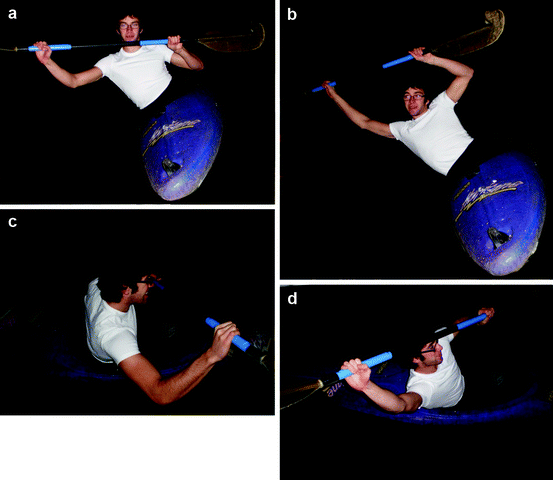

Fig. 6.8
High brace support strokes performed with good technique (a, c) and bad technique (b, d) with respect to the risk of shoulder dislocation injury. Note the highly abducted and externally rotated shoulder position (with the elbow above and behind the shoulder) indicative of bad technique. In this position the elbow is almost straight, and any force along the arm will tend to wrench to humeral head from the glenoid fossa. In addition, with the wrist behind the elbow and both behind the shoulder, there is no musculature spanning and stabilizing the front of the joint, thus leaving it prone to anterior dislocation. In contrast with good technique, the shoulder is less abducted and externally rotated (with the elbow kept below and in front of the shoulder) and the elbow is flexed
Major Traumatic Injuries
While there are no systematic scientific reports of the injuries incurred during more extreme grade V and VI descents and waterfall jumping, there are numerous press reports and online databases (e.g., American Whitewater) that provide some information about the more extreme injuries that can occur during higher grade descents where drops/falls are often involved. These injuries can include vertebral compression fractures, long bone and pelvic fractures, abdominal/chest trauma, and head injuries. Paddling high waterfall appears to involve an inherent risk of spinal compression and/or a broken spine due to the potential for high impact forces on landing particularly if the boat lands flat [3]. These injuries frequently cause temporary or permanent paralysis.
Stay updated, free articles. Join our Telegram channel

Full access? Get Clinical Tree








